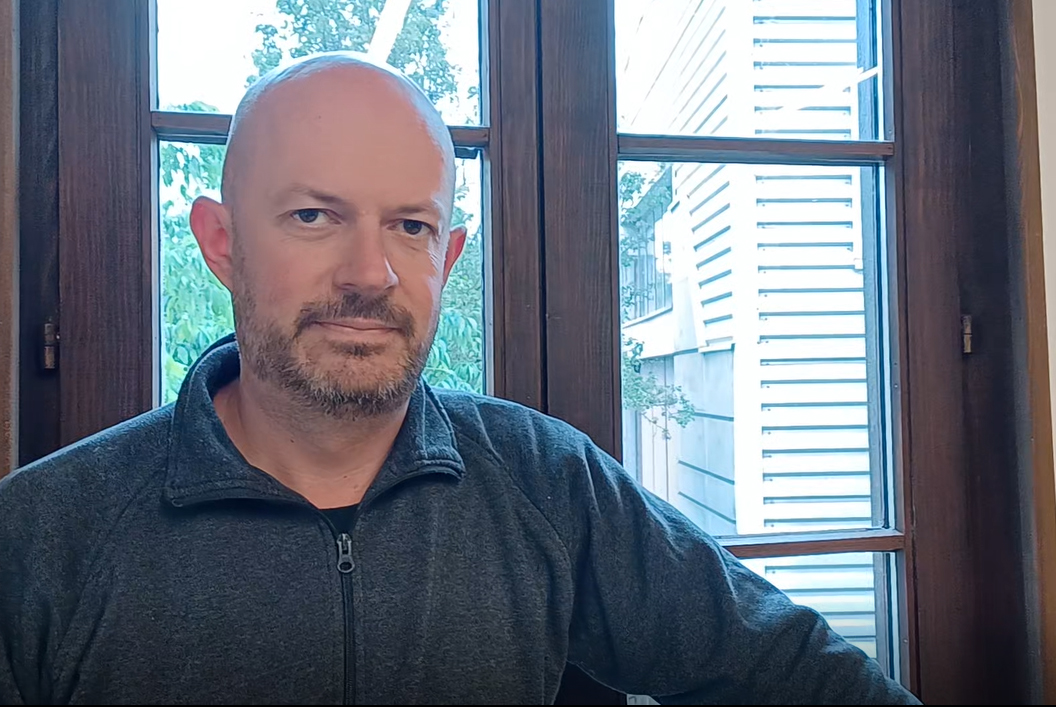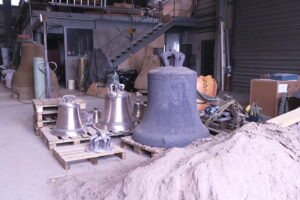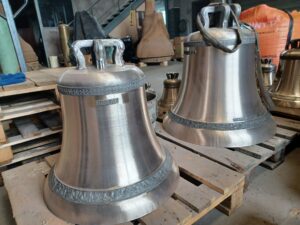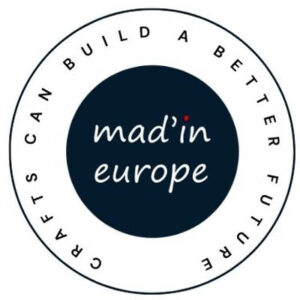This interview is part of a series of interviews with European craftspeople conducted in collaboration between FRH, the European network for religious heritage, and Mad’in Europe, the network of European fine and traditional crafts and cultural heritage restoration professions.

Julien Calcatera, Managing Director of the company André Voegele in Strasburg since 2018. © Mad’in Europe.
Julien Calcatera is currently managing director of the bell manufacturing company André Voegele. Based in Strasbourg, this bell foundry restores and casts new bells for village churches and national monuments. In order to ensure generational renewal and tackle the lack of staff, Voegele also offers a training programme for young people interested in this centuries-old craft. Learn about their work at the foundry and how they are addressing the current challenges in this interview.
1. Please introduce yourself (profession, area of expertise and years of experience).
I’m Julien Caltatera, I’ve been working in the André Voegele company in Strasbourg since 2015 and I’m the manager of the company since 2018. We are a company of bell makers, which means that we create, cast, restore, repair and maintain monumental bells.
2. What clients/markets do you work with (are they local, national or international)? Which needs does your work generally tackle? Which are the required skills and certifications that your customers request?
Our main clients are parishes and local communities. We can also be dealing with the State as a client when the monuments belong to the State. We do not have any particular certifications as we can find in the building sector. It is the expertise, the years of experience, our achievements that lead architects to us.
3. Please briefly explain how your profession is related to religious heritage and/or cultural heritage.
Our activity is completely linked to cultural and religious heritage since we work on church bells, but beyond the religious interest, villages rely on our expertise to enhance their local identity. Indeed, people remain attached to their heritage even if they are not necessarily religious.
4. Please describe the main steps of your usual working process and the materials that you use most.
The materials we use the most are essentially wood for all the accessories that support the bells, such as the belfry. It is local wood from French forests. For new bells, we use bronze, an alloy of 80% copper and 20% tin. They are richer in tin than usual bronze, because tin gives a particular resonance to bells. Moulds are made with natural clay, horse manure,and water in a special proportion. We also work with steel since we have an iron workshop for all the other accessories of the bells. Occasionally, we use special materials such as lacquered aluminium for the clock faces. For the creation of our moulds, we work with traditional and natural materials like clay, mixed with horse droppings and water. No chemical components or moulding sand. Our workshop is also specialised in the restoration of ancient bells. We are only a few doing this nowadays.

New bells and ancient bell to be restored for a French castle in Loire Valley. © Mad’in Europe.
5. Do you regularly cooperate with craft professionals from other fields? If yes, can you explain which ones and why?
We sometimes collaborate with other craftsmen on big projects, when we are working on the restoration of a building for example. We have the opportunity to collaborate with masons and stonemasons since the structures that support the bells are inserted into an existing building. We give indications to the stonemason to plan the structures that will support the belfry and the bells.
6. Please mention any innovation that helped improve your work (technological, digital, material related, legal…) and explain the impact they had on your profession.
Our works are made in a very traditional way, there is no really big innovation as far as the moulding of the bells and the manufacturing of their accessories are concerned. It is essentially the tools that have been modernised to allow the craftsmen to work in better conditions. The innovations concern mainly the motorization and the automation of the bell ringing, since the bells are no longer rung manually. They are controlled with electronic clocks and special motors that work contactlessly.
7. How did you learn the profession? Can you detail your learning path mentioning schools and workshops where you were trained?
I knew the company as a customer since I was in charge of a project for the parish of my own village. The project entailed the adding of 3 bells, which I carried out at the time with André Voegele. It is at the end of this project that André offered me to collaborate with him. So I joined the company and trained in the field, in the bell towers, in the workshop… There is no specific school for the job of bell founder or bell maker. Everything is learned by doing, in a workshop, with expert masters.

Polished bells for a French castle in the Loire Valley. © Mad’in Europe.
8. Do you pass on your knowledge to young people? If yes, how? In schools, through workshops…?
For the transmission of skills, we recruit young employees when we can, who may have a basic training but who are taught the specificities of the trade. We also often receive “compagnons du tour de France” (French young graduates undertaking a learning journey in France with masters, who pass on their knowledge and experience of the trade). They spend a year with us, in foundry or locksmithing. We recently had 2 girls who stayed with us for a year in foundry, one of whom opened her own art foundry workshop. However, it is hard to find enough apprentices and employees to cover all the needs of the profession.
9. What would you recommend to a young person interested in your profession? What are the opportunities and areas in which they can work with your skills?
Some skills are required to start in this profession, such as basic training in general fields like locksmithing or foundry but it could also be experience in industrial maintenance, electrical engineering or electricity since bells are now automated. In addition to these skills, you need to be motivated and persevering because although we work in exceptional settings, the work in the bell tower is not always easy. We travel very often, we are subject to the constraints of the weather and the height at which the bells are located…
10. Which are the threats that may endanger your profession? Can you mention some difficulties that are associated with your work? Which could be the solutions to better support your profession and preserve the transmission of skills?
The danger lies in the difficulty of small municipalities and parishes to maintain their heritage. These small communities cannot afford the heavy investment that the maintenance of bells represents. The transmission of skills is also a major issue in my profession since theory is not enough, we need craftsmen in the field and I have trouble finding them because of the constraints I mentioned earlier. Passing on our skills requires more communication and a revaluation of our profession since, in the end, few people know what a bell maker is. There would be a lot to do if all the municipalities could afford it, but we are understaffed in the bell-making sector.
You can find out more about Julien Caltatera’s work and André Voegele’s company on this website and on Facebook.
 Mad’in Europe (MIE) is a small company committed to promoting craft professionals and crafts professions and to supporting the transmission of crafts skills at a European level. Its multilingual portal gathers a large audience around the profiles of 1,500 crafts, restorers and fine crafts professionals. As a member of some European organizations and thanks to its wide European network MIE participates in several transversal activities including Erasmus and Horizon projects which focus on valorisation of crafts, preservation of traditional know-how, and raising awareness among young people, for whom the sector represents a source of employment.
Mad’in Europe (MIE) is a small company committed to promoting craft professionals and crafts professions and to supporting the transmission of crafts skills at a European level. Its multilingual portal gathers a large audience around the profiles of 1,500 crafts, restorers and fine crafts professionals. As a member of some European organizations and thanks to its wide European network MIE participates in several transversal activities including Erasmus and Horizon projects which focus on valorisation of crafts, preservation of traditional know-how, and raising awareness among young people, for whom the sector represents a source of employment.
 Future for Religious Heritage (FRH) is an independent, non-faith, non-profit European network founded in 2011 and based in Brussels to promote, encourage and support the safeguard, maintenance, conservation, restoration, accessibility and embellishment of historic places of worship. Our network represents more than 80 organisations and over 120 professionals from 36 countries, which includes NGOs, governmental organisations, religious and university departments, and individuals. We are one of the 36 European networks currently supported by the Creative Europe Networks programme.
Future for Religious Heritage (FRH) is an independent, non-faith, non-profit European network founded in 2011 and based in Brussels to promote, encourage and support the safeguard, maintenance, conservation, restoration, accessibility and embellishment of historic places of worship. Our network represents more than 80 organisations and over 120 professionals from 36 countries, which includes NGOs, governmental organisations, religious and university departments, and individuals. We are one of the 36 European networks currently supported by the Creative Europe Networks programme.





Follow us: